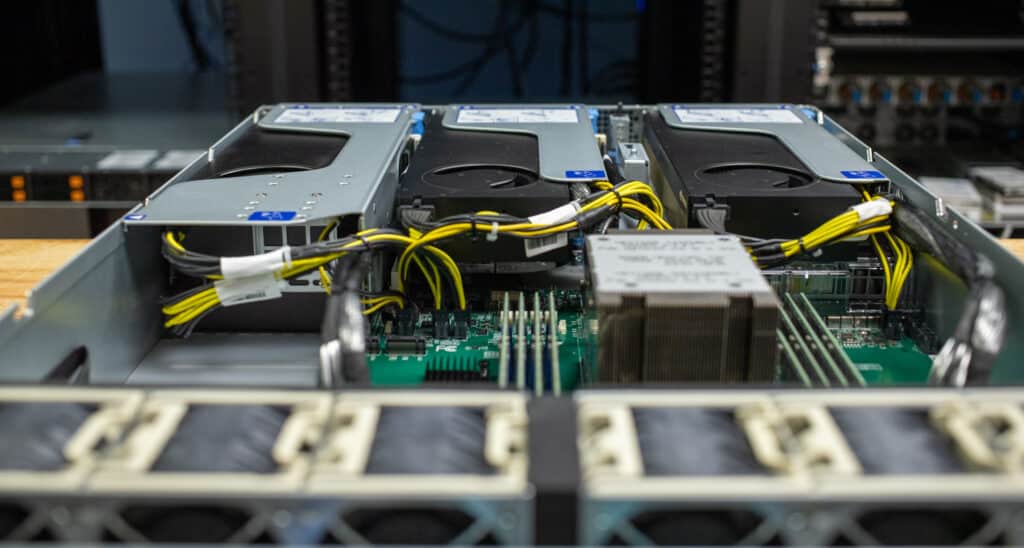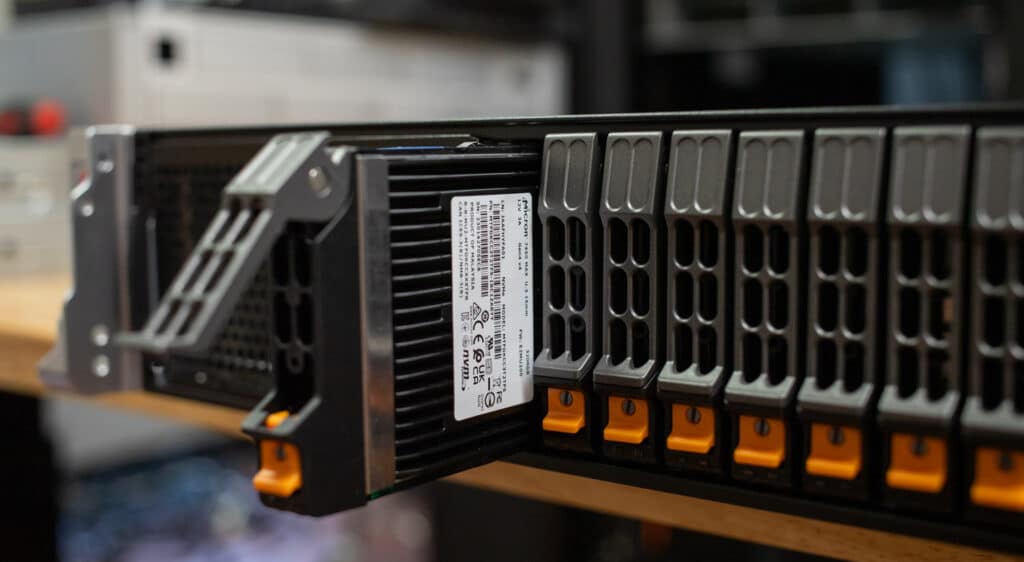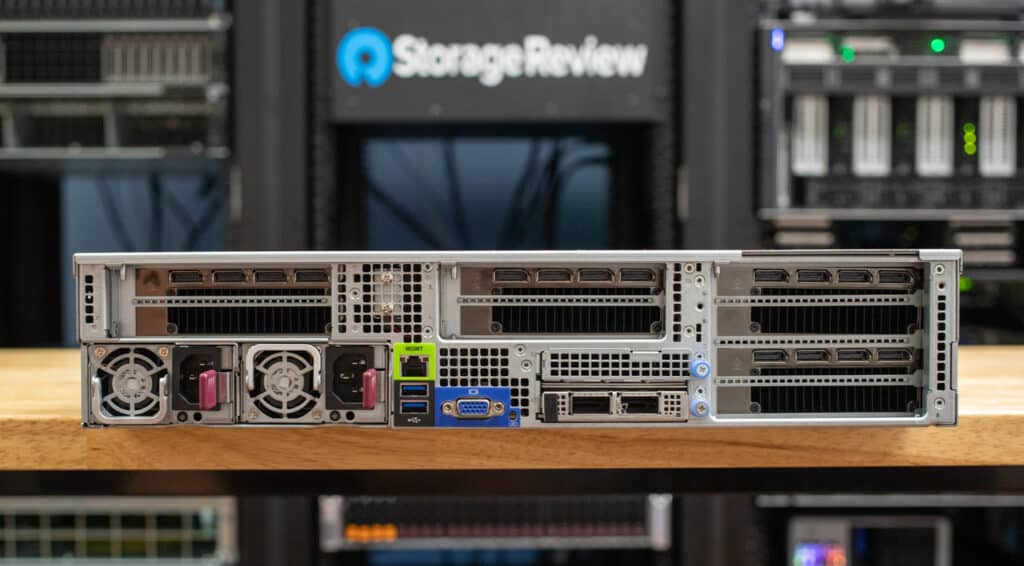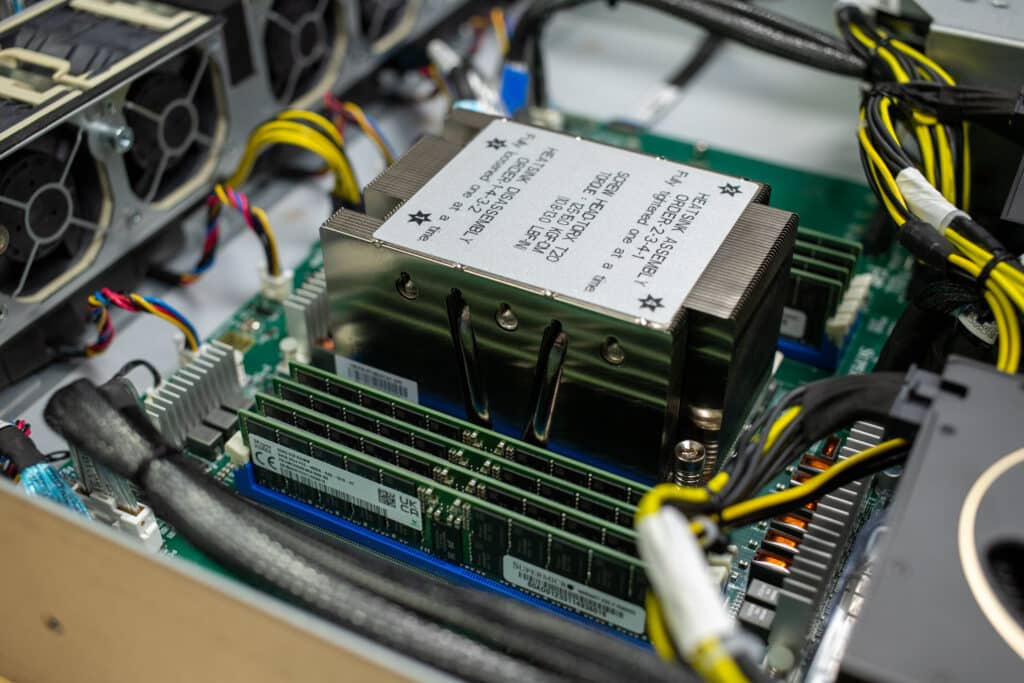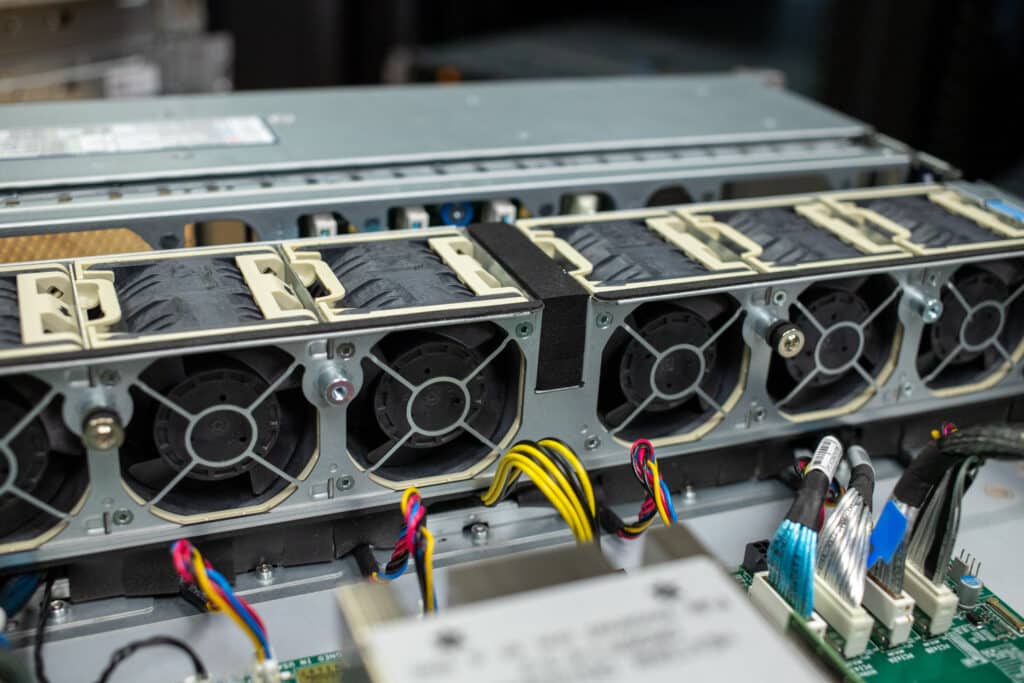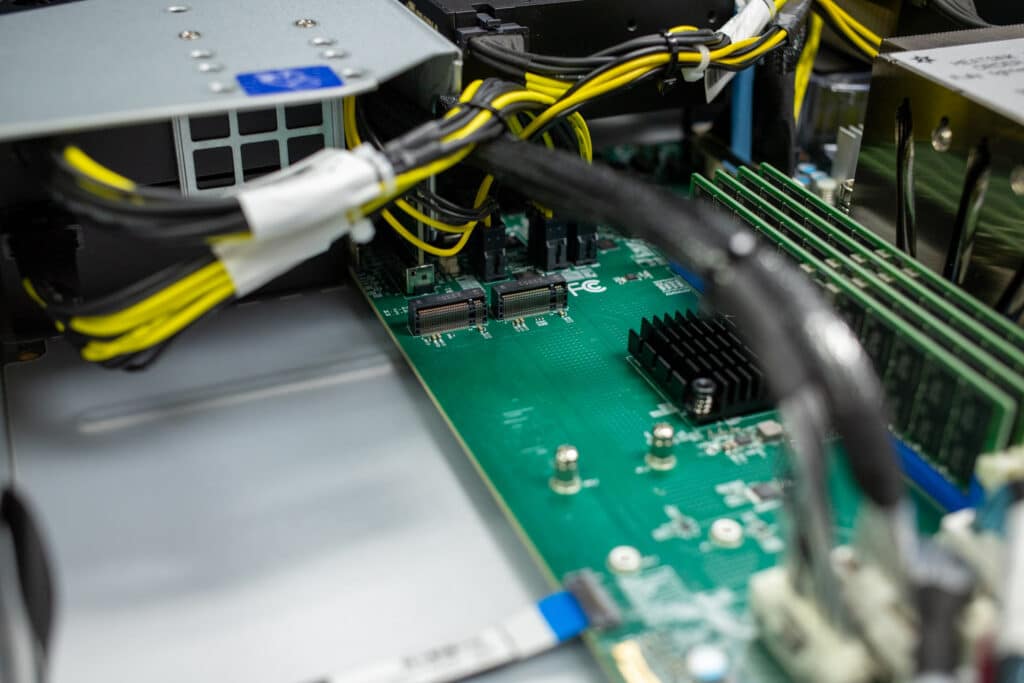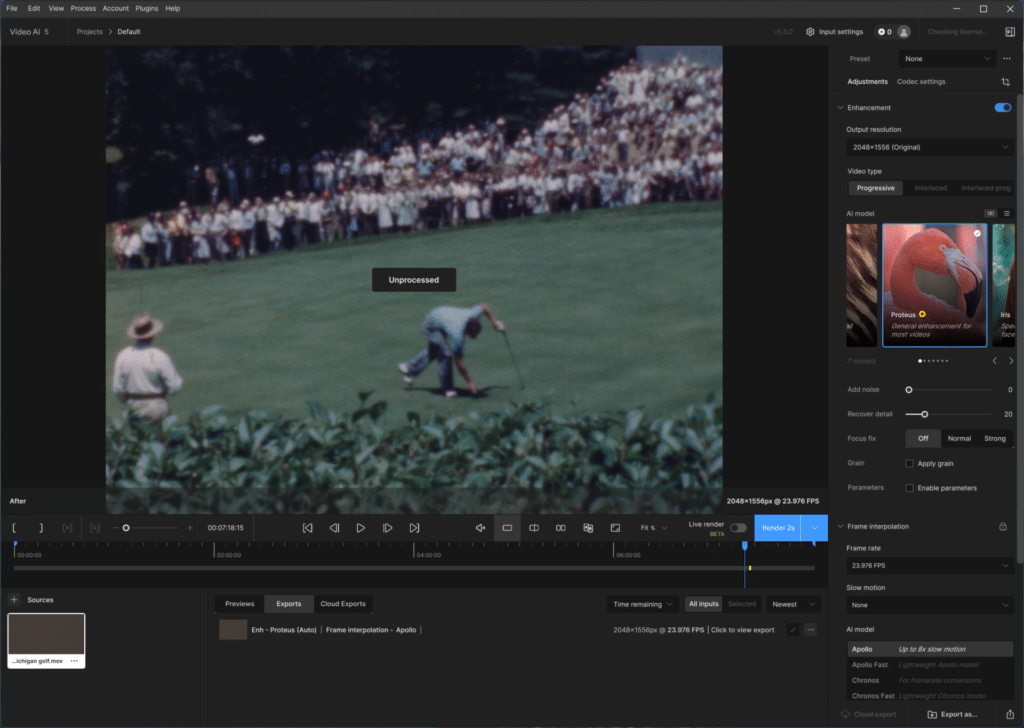The Supermicro AS-2115HV-TNRT workstation is a powerful tool for deep learning, AI model training, and other computation-heavy applications.
The Supermicro AS-2115HV-TNRT is a powerhouse workstation designed for professionals working on demanding tasks like deep learning, AI model training, and other computation-heavy applications. Its blend of server-grade durability and high-end workstation performance stands out, making it a strong choice for scenarios where both power and reliability are essential.
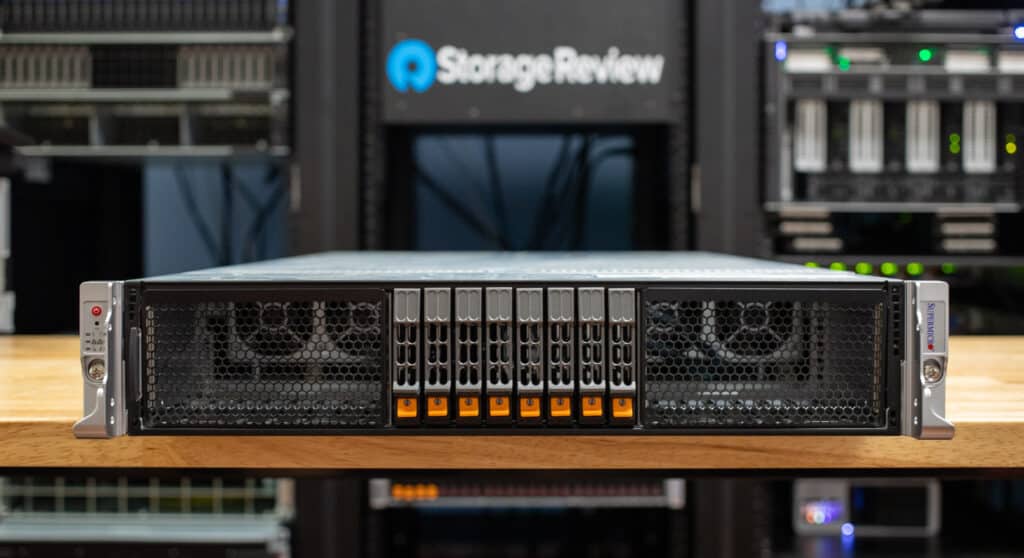
Supermicro AS-2115HV-TNRT Components and Features
At the heart of the AS-2115HV-TNRT is the AMD Ryzen Threadripper PRO 7000 WX-series processor, launched in October 2023. This CPU can tackle intensive multi-threaded workloads, delivering impressive computing power and advanced memory support.
The Threadripper PRO 7000 WX-series is a significant upgrade over previous models, offering the kind of parallel processing power essential for multitasking-heavy applications. The 384MB of L3 cache ensures that frequently used data is readily available, cutting down on latency and speeding up compute processes that rely on fast access to cached data. Plus, with a 350W thermal design power (TDP), this processor can sustain peak performance over long periods. The AS-2115HV-TNRT’s six heavy-duty fans keep things cool, even when handling demanding workloads.
We’re using the AMD Ryzen Threadripper PRO 7995WX for the AS-2115HV-TNRT. This top-tier option in the series boasts an impressive 96 cores and 192 threads, making it a perfect choice for handling extreme multi-threaded workloads.
The system can be outfitted with up to 2TB of DDR5 memory with speeds of up to 5200MT/s and ECC (Error-Correcting Code) memory for applications where data integrity is critical. ECC detects and corrects single-bit memory errors that could go unnoticed in non-ECC setups. For users seeking to squeeze even more performance from the AS-2115HV-TNRT, it also supports memory overclocking, allowing DDR5 speeds to be pushed even higher when necessary. However, it’s essential to be wary of the system’s cooling limitations and ensure proper cooling before pushing the hardware to its limits.
As we’ve seen with other rack-mount workstations, such as the HP Z4 Rack G5, putting desktop GPUs in a pass-through airflow system can restrict airflow to the GPUs. The NVIDIA RTX 6000 Ada draws its air in front, above, and below the GPU, which turns into a very tight fit in a server-style chassis. As you can see above, the intake ports are sandwiched against the case, another GPU, or the top lid of the system. We didn’t see any overheating issues, but it is one thing to keep in mind when pushed to the max over extended periods.
The AS-2115HV-TNRT also supports the PCIe Gen5 interface and up to four full-length, double-width GPUs, ideal for tasks that require GPU-accelerated computing, including deep learning, high-resolution 3D rendering, and complex video editing. This is especially useful in AI model training, where data constantly flows between storage, GPU, and CPU.
Moreover, the new Supermicro system provides eight front-accessible 2.5″ hot-swappable bays that support NVMe, SAS, or SATA drives, making it easy to configure for either speed or storage density, depending on the application. With two M.2 PCIe 4.0 slots, users can install high-speed NVMe SSDs directly on the motherboard, perfect for applications needing ultra-fast storage access, whether as a boot drive or for frequently accessed data.
The AS-2115HV-TNRT also offers a range of redundant power options. Standard configurations include dual 2600W Titanium-level redundant power supplies, with optional 1600W or 2000W setups for environments requiring different power redundancy levels. This redundancy ensures continuous operation even if one power supply fails and provides stability crucial for critical workloads where uptime is a priority.
In addition, the AS-2115HV-TNRT comes equipped with enterprise-grade management features for remote monitoring and maintenance. With a dedicated BMC LAN port, IT administrators can remotely access and control the system—an essential tool for maintaining performance and troubleshooting issues in multi-rack setups. Supermicro’s management software suite (such as SuperCloud Composer and SuperDoctor) offers comprehensive tools for monitoring system health, temperature, and performance metrics, ensuring smooth operation and efficient resource allocation.
| Supermicro AS-2115HV-TNRT Specifications | |
| Target Applications | Deep Learning, AI/Machine Learning, Cloud Gaming, Rack Workstation |
| Form Factor | 2U Rackmount |
| Processor | Single AMD Ryzen™ Threadripper™ PRO 7000 WX-Series, sTR5 socket, up to 96 cores / 192 threads, 384MB cache, 350W TDP |
| Memory Support | Up to 2TB DDR5 ECC RDIMM, 8 DIMM slots, 5200MT/s |
| Memory Features | ECC Registered, Overclocking support, Memory error detection and correction |
| PCIe Slots | – Option 1: 4x PCIe 5.0 x16 FHFL slots – Option 2: 8x PCIe 5.0 x8 FHFL slots – 1 AIOM/OCP NIC 3.0 Slot (OCP 3.0 compatible) |
| GPU Support | Up to 4 double-width GPUs (e.g., NVIDIA RTX A6000, L40S, RTX 6000 Ada Generation) |
| Drive Bays | 8x 2.5″ front hot-swap bays supporting NVMe, SATA, or SAS drives |
| M.2 Storage | 2x M.2 PCIe 4.0 x4 NVMe slots (M-key 22110/2280) |
| Network Connectivity | 1x RJ45 Dedicated BMC LAN Port, Optional AIOM Slot for network expansion |
| I/O Ports | 2x USB 3.0 (rear), 1x VGA Port |
| Cooling | 6x 6cm heavy-duty fans, optimized for high airflow and temperature control |
| Power Supply | 2x 2600W Redundant (1+1) Titanium Level Power Supplies (Optional: 1600W or 2000W) |
| Management | – Dedicated BMC with IPMI support for remote management – Supermicro software suite: SuperCloud Composer, SuperDoctor, Server Manager |
| BIOS | AMI 256MB SPI Flash, UEFI 2.9, ACPI 6.5, SMBIOS 3.5 |
| Security | – TPM 2.0, Silicon Root of Trust (NIST 800-193 Compliant) – Cryptographically signed firmware, secure boot, system lockdown |
| Physical Dimensions | – Height: 3.5″ (88.9 mm) – Width: 17.2″ (437 mm) – Depth: 31.74″ (806.2 mm) – Net Weight: 45 lbs (20.5 kg), Gross Weight: 75 lbs (34 kg) |
| Operating Temperature | 10°C ~ 35°C (50°F ~ 95°F) |
| Certifications | RoHS Compliant, UL/CSA Certified |
Supermicro AS-2115HV-TNRT Design and Build
The Supermicro AS-2115HV-TNRT workstation packs high performance into a compact 2U chassis, making it perfect for dense, rack-mount setups. This workstation is built with functionality and easy maintenance in mind, making it an excellent choice for data centers, research labs, and environments running demanding applications.
The front panel of the AS-2115HV-TNRT features a control panel with LED indicators and eight 2.5″ NVMe/SATA/SAS hot-swap drive bays right in the center of the system. Each bay has an activity indicator, so you can quickly check the status of individual drives at a glance. This setup makes adding or replacing storage easy without needing to power down the system, making maintenance and upgrades simple—especially in data-heavy environments.
The control panel is simple and easy to navigate, with LED indicators for critical system statuses. It has LEDs for power, drive activity, network activity (NIC1 and NIC2), power failure, and system information. There’s also a UID button to help locate the system in rack environments and a power button to manage power states. This design makes it easy for operators to monitor the system’s health in real time, and the UID feature adds extra convenience in multi-rack setups.
The rear of the AS-2115HV-TNRT has all the connectivity and power redundancy options you need. It’s equipped with dual 2600W Titanium-level redundant power supplies, so it can keep running even if one power source fails. For connectivity, you get two USB 3.2 ports, a VGA port, and a dedicated BMC LAN port for remote management.
The rear panel also supports flexible PCIe 5.0 expansion, allowing for either four x16 slots or eight x8 slots. This setup can handle a wide range of hardware, including up to four double-width GPUs, which makes it perfect for demanding tasks like AI training, data analysis, and complex simulations. Plus, it features an AIOM/OCP NIC 3.0 slot, offering advanced networking options for high-speed data processing and transfers.
Removing the top cover on the AS-2115HV-TNRT was easy. With just a press of the release lever at the rear, we slid the cover back and lifted it off, giving us quick access to all the internal components. As expected from Supermicro, the components are well organized and designed for tool-free adjustments, making any future setup or configuration smooth and hassle-free.
Six heavy-duty fans are positioned across the CPU, memory, and PCIe slots to help maintain stable temperatures during intense workloads. The single AMD Ryzen Threadripper PRO 7995WX processor is centrally located, with eight DIMM slots arranged to support up to 2TB of DDR5 ECC memory. The two M.2 slots for boot storage are accessible from the top, providing flexibility to dedicate the front-mount 2.5″ bays for high-capacity and high-speed storage configurations.
While the system’s internal design has some decent airflow, it’s essential to be mindful of the AS-2115HV-TNRT’s cooling limitations when adjusting performance profiles (i.e., overclocking), as the air cooling may be insufficient for excessive thermal loads.
Is it Really a Workstation?
The Supermicro AS-2115HV-TNRT is sold as a workstation, although many of our social media followers have debated hotly, “What makes this different from a traditional server?” On the workstation side of the ledger, the system offers end-user GPUs and a prosumer CPU. It also provides plenty of server-type features though, such as a 2U rack-mount form factor, eight U.2 NVMe SSD slots in front, and redundant power supplies in the rear.
Much of the differentiation in qualifying this system as a server or workstation will be the use case. The workstation naming fits best if its primary access mode is local control with a single-user OS (Windows 11). If the access will be over a multi-user OS (Windows Server) over a shared network, a server is probably the best bucket to place it in. In either event, it’s a fantastic piece of hardware that benefits from the obvious flexibility that fuels the debate over its proper designation.
Supermicro AS-2115HV-TNRT Performance
As always, we’ll be putting the new Supermicro AS-2115HV-TNRT through a series of rigorous benchmarks to evaluate its performance across a range of demanding workloads. This testing will give us insight into how it handles resource-intensive applications such as AI model training, large-scale simulations, and real-time rendering. For our review, the Supermicro AS-2115HV-TNRT is configured with the following high-performance components:
- Operating System: Microsoft Windows Server 2025
- Processor: AMD Ryzen Threadripper PRO 7995WX (96 cores, 192 threads)
- Memory: 520GB (8x 65GB DDR5-4800 ECC)
- Storage: 1x Micron 7450 Max 3.2TB NVMe SSD
- Graphics: 4x NVIDIA RTX 6000 Ada GPUs
- Power Supply: Dual 2000W PSUs (redundant configuration)
To provide context for our results, we’ll compare the AS-2115HV-TNRT against HP’s Z8 Fury G5, another high-end workstation with four GPUs. Here’s how we configured the Z8 Fury G5 for our tests:
- Operating System: Windows 11 Pro
- Processor: Intel Xeon w9-3945X (56 cores, 112 threads, up to 4.8GHz with Turbo Boost, 350W base power)
- Memory: 128GB DDR5-4800 ECC (16x 8GB, quad-channel)
- Storage: 2x 1TB Gen4 SSDs (non-RAID)
- Graphics: 4x NVIDIA RTX A6000 GPUs
- Power Supply: 2250W (2x 1,125W redundant units)
With its higher core count and substantial 384MB cache, the 96-core, 192-thread AMD Threadripper PRO will likely dominate in highly parallelized workloads such as scientific computing, data analysis, and large-scale simulations.
On the GPU front, the RTX 6000 Ada cards in the AS-2115HV-TNRT feature an updated architecture, improved specifications, and enhanced energy efficiency compared to the previous-generation RTX A6000 GPUs in the Z8 Fury G5. These improvements should translate to noticeable gains in compute and rendering tasks, especially in GPU-intensive benchmarks like deep learning model training and 3D rendering. Nonetheless, this head-to-head comparison will showcase how the AS-2115HV-TNRT stacks up against another high-end, GPU-dense competitor (albeit with less powerful components).
With it being supported by the platform, we also tested an overclocked configuration. The settings adjusted the AMD Precision Boost Overdrive area. These settings were stable for our tests, although the results may vary.
- Precious Boost Overdrive: Advanced
- PBO Limits: Manual
- PPT Limit (mW): 1,000,000
- TDC Limit (mA): 538,000
- EDC Limit (mA): 770,000
- Precision Boost Overdrive Scalar Ctrl: Manual
- Precision Boost Overdrive Scalar: 10X
- CPU Boost Clock Override (+): Enabled Positive
- Max CPU Boost Clock Override (+): 100
- Platform Thermal Throttle Ctrl: Manual
- Platform Thermal Throttle Limit: 100
- Curve Optimizer
- Core Optimizer: All Cores
- All Core Curve Optimizer Sign: Negative
- All Core Curve Optimizer Magnitude: 25
Blender OptiX
Blender OptiX is an open-source 3D modeling application. The score is “samples per minute,” with higher scores being better. We examine this benchmark’s CPU and GPU versions with the Supermicro, including individual tests focusing on the GPU and the CPU.
Here, the Supermicro AS-2115HV-TNRT delivered impressive results, especially in GPU-intensive tasks. Equipped with four NVIDIA RTX 6000 Ada GPUs, it achieved excellent performance across all scenes, with the “Monster” scene reaching 5,745 samples per minute (much faster than the HP Z8 system). The overclocked version of the AMD Ryzen Threadripper PRO 7995WX slightly improved the CPU-based performance in the Blender test, with scores increasing from 931 to 969 samples per minute in the “Monster” scene.
The Ada GPUs’ updated architecture and improved energy efficiency translate to faster render times, with the “Monster” scene reaching 5,745 samples per minute—a considerable leap over the A6000-equipped HP system.
| Blender OptiX (Samples per minute, Higher is better) | ||||
| Category | Supermicro AS-2115HV-TNRT (AMD 7995WX, 4x RTX 6000 Ada)
GPU |
Supermicro AS-2115HV-TNRT (AMD 7995WX, 4x RTX 6000 Ada)
CPU |
Supermicro AS-2115HV-TNRT Overclocked (AMD 7995WX, 4x RTX 6000 Ada)
CPU |
HP Z8 Fury G5 – GPU (Xeon w9-3945X, 4x RTX A6000) |
| Monster | 5,745 | 931 | 969 | 2,814 |
| Junkshop | 2,698 | 682 | 640 | 1,781 |
| Classroom | 2,824 | 451 | 472 | 1,519 |
Luxmark
Another 3D benchmark we run is LuxMark, an OpenCL GPU benchmarking utility. This multi-GPU friendly test is precisely what we need for these 4-GPU configurations.
Nonetheless, the AS-2115HV-TNRT also excelled in LuxMark. In both the “Hallbench” and “Food” scenes, the Supermicro system outperformed the HP Z8 Fury G5 substantially. With a score of 129,797 in Hallbench, the AS-2115HV-TNRT showcases the efficiency of the Ada GPUs when running parallel rendering tasks, almost doubling the HP system’s score of 82,265.
| Luxmark (Higher is better) | ||
| Supermicro AS-2115HV-TNRT (AMD 7995WX, 4x RTX 6000 Ada) | HP Z8 Fury G5 (Xeon w9-3945X, 4x RTX A6000) | |
| Hallbench | 129,797 | 82,265 |
| Food | 60,256 | 31,242 |
Blackmagic RAW Speed Test
We have also started running Blackmagic’s RAW speed test, which tests video playback.
Here, the AS-2115HV-TNRT’s four RTX 6000 Ada GPUs demonstrated impressive results in the Blackmagic RAW Speed Test, achieving 664 fps in the 8K CUDA test—well above the HP Z8 Fury G5’s 444 fps with the older RTX A6000 GPUs. For CPU-based processing, the Supermicro’s Threadripper PRO reached 132 fps, slightly surpassing the HP system’s 126 fps.
| Blackmagic RAW Speed Test | Supermicro AS-2115HV-TNRT (AMD 7995WX, 4x RTX 6000 Ada) | HP Z8 Fury G5 (Xeon w9-3945X, 4x RTX A6000) |
| 8K CPU | 132 fps | 126 fps |
| 8K CUDA | 664 fps | 444 fps |
Cinebench
Maxon’s Cinebench R23 is a CPU rendering benchmark that utilizes all CPU cores and threads. We ran it for both multi- and single-core tests.
In the Cinebench R23 benchmark, the overclocked system scored 132,044 points in the multi-core test, a notable improvement over the 111,792 points in the non-overclocked version, and maintained its dominance over the HP Z8 Fury G5’s 44,416 points. The single-core performance also slightly boosted, increasing from 1,864 to 1,887 points. The overclocked configuration further showcased the system’s impressive multi-threading capability, making it even more suitable for CPU-heavy tasks like rendering and simulations.
| Cinebench R23 | Supermicro AS-2115HV-TNRT (AMD 7995WX, 4x RTX 6000 Ada) |
Supermicro AS-2115HV-TNRT – Overlocked (AMD 7995WX, 4x RTX 6000 Ada) |
HP Z8 Fury G5 (Xeon w9-3945X) |
| CPU (Multi-Core) | 111,792 points | 132,044 points | 44,416 points |
| CPU (Single-Core) | 1,864 points | 1,887 points | 1,558 points |
| MP Ratio | 59.98x | 69.99x | 28.51x |
Cinebench 2024 extends the benchmark capabilities of R23 by adding GPU performance evaluation.
This time, the non-overclocked Supermicro AS-2115HV-TNRT put up impressive numbers, with a GPU score of 109,847 points and a multi-core CPU score of 5,927 points. This shows how well this system handles multi-threaded tasks, making it an excellent fit for workloads that require a balance of GPU and CPU power. Interestingly, the overclocked version scored slightly lower on GPU performance, reaching only 108,507 points. This could have been attributed to the overclocking process pushing the CPU to its limits, potentially leading to more heat generation and throttling.
Regarding multi-core CPU performance, the non-overclocked system again outperformed the overclocked version.
| Cinebench R24 | Supermicro AS-2115HV-TNRT (AMD 7995WX, 4x RTX 6000 Ada) |
Supermicro AS-2115HV-TNRT – Overlocked (AMD 7995WX, 4x RTX 6000 Ada) |
| GPU | 109,847 points | 108,507 points |
| CPU (Multi-Core) | 5,927 points | 3,624 points |
| CPU (Single-Core) | 111 points | 112 points |
| MP Ratio | 53.48x | 32.32x |
Geekbench 6
Geekbench 6 is a cross-platform benchmark that measures overall system performance. The Geekbench Browser allows you to compare any system to it.
The AS-2115HV-TNRT again demonstrated its superior CPU and GPU power. With a single-core CPU score of 2,875 and a multi-core score of 24,985, the Supermicro system surpassed the HP Z8 Fury G5, which scored 2,179 and 18,515, respectively. The AS-2115HV-TNRT shines in multi-core performance, showcasing just how efficient the Threadripper PRO architecture is with diverse workloads. Its OpenCL GPU score of 307,510 also outpaced HP’s 179,618, demonstrating the Ada GPUs’ impressive power in parallel processing.
| Geekbench 6 | Supermicro AS-2115HV-TNRT (AMD 7995WX, 4x RTX 6000 Ada) | HP Z8 Fury G5 (Xeon w9-3945X, 4x RTX A6000) |
| CPU Benchmark – Single-Core | 2,875 | 2,179 |
| CPU Benchmark – Multi-Core | 24,985 | 18,515 |
| GPU Benchmark – OpenCL | 307,510 | 179,618 |
y-cruncher
y-cruncher is a multi-threaded and scalable program that computes Pi and other mathematical constants to trillions of digits. Since its inception in 2009, it has become a popular benchmarking and stress-testing tool for overclockers and hardware enthusiasts. The program’s ability to utilize all available CPU threads makes it an excellent test of processing power and system stability.
The non-overclocked Supermicro AS-2115HV-TNRT performed well under multi-threaded tasks, completing the 10-billion-digit Pi calculation in 67.849 seconds. The overclocked version significantly improved this, completing the same task in 58.283 seconds. Across smaller digit calculations, the non-overclocked version held its own, providing reliable performance, but the overclocked configuration noticeably outpaced it in handling extreme computational loads. Nonetheless, both configurations are highly capable of performing large-scale computations.
| y-cruncher (Total Computation time) | Supermicro AS-2115HV-TNRT (AMD 7995WX, 4x RTX 6000 Ada) |
Supermicro AS-2115HV-TNRT – Overlocked (AMD 7995WX, 4x RTX 6000 Ada) |
| 1 billion digits | 8.547 seconds | 6.009 seconds |
| 2.5 billion digits | 17.493 seconds | 13.838 seconds |
| 5 billion digits | 33.584 seconds | 27.184 seconds |
| 10 billion digits | 67.849 seconds | 58.283 seconds |
| 25 billion digits | 182.880 seconds | 161.913 seconds |
| 50 billion digits | 417.853 seconds | N/A |
y-cruncher BBP
This y-cruncher benchmark utilizes the Bailey-Borwein-Plouffe (BBP) formulas to compute massive hexadecimal digits of Pi, measuring the CPU’s total computation time, utilization, and multi-core efficiency.
In the 100 BBP test, the non-overclocked Supermicro AS-2115HV-TNRT had an impressive multi-core efficiency of 98.90% with a total computation of 21.434 seconds. This demonstrates that it can effectively distribute its workload across its cores, making it ideal for CPU-heavy applications.
The overclocked configuration completed the 100 BBP test faster, with a time of 15.876 seconds. However, it showed a slightly lower multi-core efficiency at 98.84%. This minor drop in efficiency could be due to the added thermal and power strain from overclocking, which can sometimes lead to diminished returns in terms of overall system balance. In the smaller tasks, such as the 1 BBP and 10 BBP tests, the overclocked system outpaced the non-overclocked version, completing the 1 BBP test in 0.178 seconds compared to 0.256 seconds. The overclocking allowed for faster results overall, but the system was pushed closer to its limits, potentially introducing instability under sustained workloads.
| Benchmark | Supermicro AS-2115HV-TNRT (AMD 7995WX, 4x RTX 6000 Ada) |
Supermicro AS-2115HV-TNRT – Overlocked (AMD 7995WX, 4x RTX 6000 Ada) |
| 1 BBP |
|
|
| 10 BBP |
|
|
| 100 BBP |
|
|
7-zip Compression Benchmark
The built-in memory benchmark in the 7-Zip utility measures the performance of a system’s CPU and memory during compression and decompression tasks, indicating how well the system can handle data-intensive operations. We run this test at a 128MB dictionary size when possible.
The non-overclocked configuration of the Supermicro AS-2115HV-TNRT performed well in the 7-zip benchmark, with a final score of 442.709 GIPS, delivering solid results in both compression and decompression tasks. It hit 436.490 GIPS at its peak, showing how efficiently it handles data-heavy workloads. The overclocked version pushed these numbers even higher, reaching 613.366 GIPS, thanks to enhanced multi-threading. Despite the overclocked system’s performance boost, the non-overclocked version still proved highly efficient and more than capable of tackling complex, data-intensive operations.
| 7-Zip Compression Benchmark (Higher is better) | Supermicro AS-2115HV-TNRT (AMD 7995WX, 4x RTX 6000 Ada) | Supermicro AS-2115HV-TNRT – Overlocked (AMD 7995WX, 4x RTX 6000 Ada) |
| Current CPU Usage | 5,571% | 6,456% |
| Current Rating / Usage | 7.835 GIPS | 9.373 GIPS |
| Current Rating | 436.490 GIPS | 605.097 GIPS |
| Resulting CPU Usage | 5,599% | 6,433% |
| Resulting Rating / Usage | 7.863 GIPS | 9.420 GIPS |
| Resulting Rating | 440.288 GIPS | 605.984 GIPS |
| Current CPU Usage | 6,223% | 6,343% |
| Current Rating / Usage | 7.215 GIPS | 9.810 GIPS |
| Current Rating | 449.012 GIPS | 622.250 GIPS |
| Resulting CPU Usage | 6,213% | 6,312% |
| Resulting Rating / Usage | 7.165 GIPS | 9.834 GIPS |
| Resulting Rating | 445.130 GIPS | 620.749 GIPS |
| Total CPU Usage | 5,906% | 6,373% |
| Total Rating / Usage | 7.514 GIPS | 9.627 GIPS |
| Total Rating | 442.709 GIPS | 613.366 GIPS |
OctaneBench
This benchmark test was conducted using OctaneBench, a popular tool that measures the rendering performance of GPUs with the OctaneRender engine. The test includes various scenes and kernels (rendering methods) to simulate different lighting and tracing conditions, giving insight into the hardware’s efficiency under realistic workloads. The results below show the performance in “Ms/s” (megasamples per second) and compare it with a GTX 980 reference.
The info channels kernel is the fastest, outperforming other methods in every scene. For instance, the ‘Box’ scene hits an impressive 3878.27 Ms/s. Direct lighting requires more power but still holds up well, reaching 928.51 Ms/s in the ‘Interior’ scene—nearly double the speed of the most demanding method, path tracing. Path tracing, which focuses on simulating realistic lighting by tracking complex light interactions, is much slower. In the ‘ATV’ scene, for example, it only manages 694.32 Ms/s. With a final benchmark score of 5059.88, this GPU certainly demonstrates that it can handle a range of tasks well overall, but the choice of method will depend on whether you prioritize speed or realistic detail.
| Scene | Kernel | Ms/s | GTX980 Ms/s | Ratio | Weight | Score |
| Interior (by Julia Lynen) | info channels | 3790.21 | 51.52 | 73.568 | 10 | 183.92 |
| Interior (by Julia Lynen) | direct lighting | 928.51 | 17.80 | 52.163 | 40 | 521.63 |
| Interior (by Julia Lynen) | path tracing | 452.78 | 8.54 | 53.024 | 10 | 662.73 |
| Idea (by Julio Cayetaño) | info channels | 3770.79 | 85.99 | 43.851 | 10 | 109.63 |
| Idea (by Julio Cayetaño) | direct lighting | 859.78 | 21.05 | 40.845 | 40 | 408.45 |
| Idea (by Julio Cayetaño) | path tracing | 775.94 | 19.38 | 40.045 | 50 | 500.48 |
| ATV (by Jürgen Aleksejev) | info channels | 3515.07 | 31.39 | 111.981 | 10 | 279.95 |
| ATV (by Jürgen Aleksejev) | direct lighting | 807.54 | 15.21 | 53.093 | 40 | 530.93 |
| ATV (by Jürgen Aleksejev) | path tracing | 694.32 | 12.92 | 53.740 | 50 | 671.75 |
| Box (by Enrico Cerica) | info channels | 3878.27 | 65.75 | 58.985 | 10 | 147.46 |
| Box (by Enrico Cerica) | direct lighting | 690.20 | 13.84 | 49.870 | 40 | 498.70 |
| Box (by Enrico Cerica) | path tracing | 585.62 | 13.45 | 43.540 | 50 | 544.25 |
Topaz Video AI
A new workload we added to our testing process focuses on the performance of a platform running Topaz Video AI to enhance a scanned film. We have some previously unearthed footage of the 1947 U.S. Open. While the official historical footage is all black and white, while scanning some family films, we uncovered footage of many players practicing and shooting throughout the day, including the winning putt by Lew Worsham. The original footage is 8mm film, with an average framerate of 16FPS that is hand cranked. This footage was recorded by Kevin’s grandmother and offered a unique viewpoint of this tournament held in St. Louis.
The file we chose for processing is 8 minutes long and 14.6GB in size. We imported the file into Topaz Video AI, selected Proteus, the general video enhancing algorithm, and increased the framerate to 23.97FPS. The job is then batched up, with the processing time being the final score.
We’ve also run this workload on a Dell Precision 5860 with a single NVIDIA RTX 6000 Ada GPU, which gave us an average processing rate of around 5FPS and a total time of 41 minutes and 12 seconds. With the Supermicro AS-2115HV-TNRT offering four RTX 6000 Ada GPUs, we were excited to see how well Topaz Video AI Pro scales with multiple GPUs.
In our first run, we kicked off a single processing job, finishing in just 14 minutes and 28 seconds. While not a 4x increase, we did see that Topaz AI could saturate two GPUs, with some residual workload hitting the remaining GPUs. We then scaled the workload to two nearly identical jobs, processing them simultaneously. One job had the output framerate set to 23.97FPS, while the other had its output framerate targeting 24FPS. These two batch jobs finished in 18 minutes and 21 seconds and 18 minutes and 52 seconds, respectively. While certain individual workloads don’t necessarily scale across multiple GPUs, Topaz Video AI could use two GPUs per batch job pretty well. We dramatically improved our workflow by a factor of 4 by running multiple batch jobs together.
Conclusion
We found the Supermicro AS-2115HV-TNRT to be an impressive powerhouse for high-performance tasks like AI training, deep learning, and data-intensive simulations. Its compact, rack-mounted 2U form factor fits neatly into data center environments, offering the processing power you’d expect from a much larger workstation. This system balances power and efficiency for businesses that need serious performance without taking up too much space. Additionally, since it goes in the data center, organizations can expect better data security in addition to the physical security of an expensive asset.
In terms of performance, the AS-2115HV-TNRT excelled across all our tests. Equipped with the AMD Ryzen Threadripper PRO 7000 WX-series processor and four NVIDIA RTX 6000 Ada GPUs, this system delivered outstanding results, particularly in GPU-accelerated tasks such as 3D rendering and deep learning model training. It also excelled in multi-threaded CPU benchmarks. However, it’s important to note that the system is an air-cooled platform. Overclocking results and stability will be affected by room temperatures. The system maintained stable temperatures and performed reliably under our heavy workloads. The overclocked configuration boosted processing speed, although these tests weren’t performed over long periods.
Ultimately, this system is an excellent fit for AI, scientific research, video production, and other tasks typically found in the workstation world. Its flexible PCIe Gen5 slots, enterprise flash support, and extensive memory footprint allow for easy expansion and customization, making it versatile for various demanding tasks. Despite its relatively small 2U form factor (most comparable workstations are much thicker when racked), it offers a remarkable combination of power, reliability, and scalability.
Engage with StorageReview
Newsletter | YouTube | Podcast iTunes/Spotify | Instagram | Twitter | TikTok | RSS Feed

